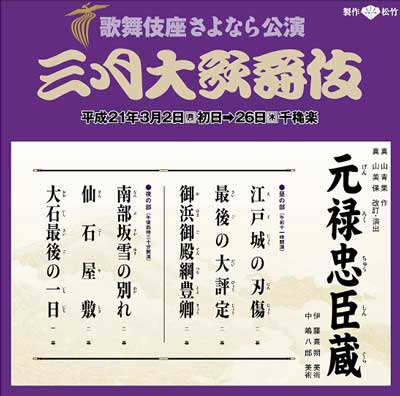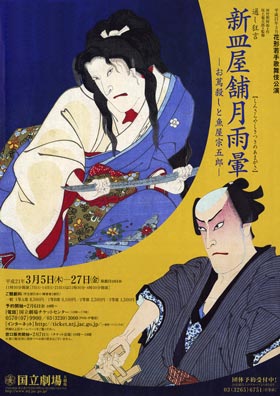| Comments |
3rd of the 16 Kabukiza Sayonara K˘en, the Kabukiza Farewell Performances, which will be held up to April 2010.
Mayama Seika's Shinkabuki masterpiece "Genroku Chűshingura" is staged as a t˘shi ky˘gen but not in its integrity.
The 6 most important parts are staged with the leading role of ďishi Kuranosuke performed by different stars:
Matsumoto K˘shir˘ ("Saigo no Daihy˘j˘" and "ďishi Saigo no Ichinichi"), Kataoka Nizaemon ("Sengoku Yashiki") and Ichikawa Danjűr˘ ("Nanbuzaka no Yuki Wakare").
There are few plays more popular in Kabuki than "Chűshingura" or the Treasury of the Forty-Seven Loyal Retainers,
the story of a true incident when a samurai lord attacked another in the Sh˘gunĺs palace,
was immediately sentenced to ritual suicide and his domain confiscated.
After much hardship, forty-seven of the lordĺs retainers avenged their lordĺs death.
When the event occurred, it was a sensation because it proved that despite a century of
peace, samurai values had not disappeared completely. In the modern period, from 1934 to
1942 even as Japan was at war in China and then plunged in World War II,
Mayama Seika (1878~1948) painstakingly reworked this play into "Genroku Chűshingura",
a vast cycle of plays in ten parts focusing on different incidents and different
characters in this revenge classic adding historical details reflecting the Genroku period.
Edo-j˘ no Ninj˘:
(The Attack in Edo Castle)
This play begins right
after the attack and follows the interrogation of Asano Takumi-no-Kami (Nakamura Baigyoku) by Tamura Uky˘dayű (Kataoka Gat˘)
and culminates in Asanoĺs ritual suicide.
Saigo no Daihy˘j˘:
(The Last Great Council)
The time to hand over the
clanĺs castle has come and the members of the clan, led by chief retainer ďishi Kuranosuke
(Matsumoto K˘shir˘), discuss what to do. Although he keeps his determination a secret,
Kuranosuke decides that he will avenge his lordĺs death and he reveals this
determination in a conversation with his old friend Iseki Tokubŕ (Nakamura Karoku).
With Nakamura Kaishun as Kuranosukeĺs wife Oriku.
Ohama Goten Tsunatoyo-ky˘:
(The Ohama Palace and Lord Tokugawa Tsunatoyo)
One of the most popular parts of this play shows Tsunatoyo (Kataoka Nizaemon),
who will be the next Sh˘gun, seemingly detached from the vendetta, but in fact,
intensely interested in the progress of the quest of the band of loyal retainers.
The play culminates in a confrontation between Tsunatoyo and Tominomori Sukeemon (Ichikawa Somegor˘),
one of the retainers as Tsunatoyo tries to find out what the plans for the vendetta are.
With Nakamura Shibajaku as Okiyo, Kataoka Hidetar˘ as Ejima and Living National Treasure Nakamura Tomijűr˘ as Tsunatoyoĺs teacher Arai Kageyű.
Nanbuzaka no Yuki Wakare:
(The Parting in the Snow at Nanbuzaka)
One snowy night, Kuranosuke (Ichikawa Danjűr˘) visits the widow of their lord and says that
he plans to retire to the countryside. In fact, he has come to say a final farewell
before the vendetta, but he cannot say this openly, since he is surrounded by spies.
The widow of his lord scolds him severely for forgetting his master,
before she realizes the truth. Featuring Living National Treasure Nakamura Shikan as Asanoĺs
widow.
Sengoku Yashiki:
(The Judgment at the Mansion of Lord Sengoku)
After the successful attack on Kiraĺs mansion, the former retainers of Asano present
themselves to the shogunate for judgment. Lord Sengoku (Nakamura Baigyoku), an official of the
shogunate questions Kuranosuke (Kataoka Nizaemon) about the incident and gradually comes to
admire him as he realizes how thoughtful and careful Kuranosuke was in planning the
attack and justifying their cause.
ďishi Saigo no Ichinichi:
(The Last Day of ďishi Kuranosuke's Life)
"ďishi Saigo no Ichinichi is a particularly popular play, which is often performed
independently and although it is the last play in the cycle, was the first to be
written and its success inspired the cycle of plays. In this play.
ďishi Kuranosuke (Matsumoto K˘shir˘) is shown being torn between the severe samurai duty that has
made their mission a success and the desire to let a young couple meet one last
time before they must die. The masterless samurai of the Ak˘ clan have successfully
completed their unauthorized vendetta and are being housed at the mansion of a
samurai lord while their fate is being decided. The vendetta has caused a
sensation and a young boy comes to meet the men as they are imprisoned.
The boy turns out to be a woman in disguise, Omino (Nakamura Fukusuke), hoping to meet her
betrothed, Jűr˘zaemon (Ichikawa Somegor˘), one of the group. But until they know whether they
will be able to have honorable deaths by ritual suicide or die by execution like
common criminals, the leader of the group ďishi Kuranosuke, cannot allow her to
meet her fiance.
Source: Earphone Guide website
|


